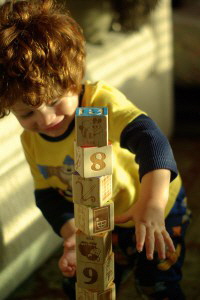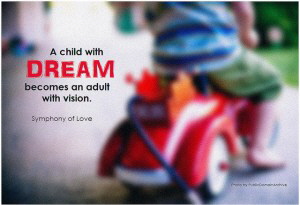|

How and Why to Teach Goal Setting to Kids
November 29, 2014
The basics of goal setting is simple: be successful as many times as you can. Plan to celebrate successes frequently by having goals that are easily attained. The younger the goal setter the more easily attained the goal needs to be so success and rewards will be more immediate. Break down big goals for lots of rewards and celebrations along the way.
Children have a lot to do. In eighteen years, after high school, they will be going off into the world by themselves. In just a few years they will be responsible for their actions, friendships and grades at school. Whether your children know it or not they have a lot to accomplish. Your children will have their own ideas about what is important too. They will have their own ideas, wants, needs and desires, besides all the achievements society has laid out for them. Goal setting is another tool we, parents, can stick in their tool belt to equip them for getting what they want.
Never too early to start goal setting. Obviously the more skills the dreamer has, the easier it will be to introduce more and complex tools to help them. Reading and writing will be necessary before they can update their own charts and written goals. Critical thinking skills are required to appreciate and implement concepts like deferred gratification. In the mean time you may help them find and post pictures of things they want and show them how you update your tooth brushing chart on a daily basis.
Catch Them Being Right
Toddlers, well all of us really, love being praised. Positive reinforcement is the primary motivator for real change.
- “A large part of the leader’s role in creating the best working environment is to make sure that positive reinforcement is understood and delivered for the right behaviors, at the right time, and at the right frequency.That means that all policies and procedures should be inspected from this perspective: You get more of what you reinforce. Emphasize the wrong behavior and you get more of it. It is a folly to reinforce one behavior and expect another…” Aubrey Daniels
Here’s the pdf which explains that the five rules for efficient and effective positive reinforcement are: Personal, Immediate, Frequent, Earned, and Social. Aubrey Daniels is the author of business books like ” Oops! “ and “Bringing Out the Best in People“.
 Catch them being right as often as you can. With regard to goals this may mean when you see your toddler stacking blocks and trying again and again to get that sixth block on the top you mention it to her. Get down on her level, look her in the eye, and say something like, “I like the way you are sticking with your block stacking. It looks like you are trying to make a tall stack is that right? Well looks like you have it under control. I like the way you keep trying. I know you can do it” Then give them a little squeeze or hug as appropriate. See if they are ready for a snack or something else you can do for them. Maybe they want help stacking blocks. Catch them being right as often as you can. With regard to goals this may mean when you see your toddler stacking blocks and trying again and again to get that sixth block on the top you mention it to her. Get down on her level, look her in the eye, and say something like, “I like the way you are sticking with your block stacking. It looks like you are trying to make a tall stack is that right? Well looks like you have it under control. I like the way you keep trying. I know you can do it” Then give them a little squeeze or hug as appropriate. See if they are ready for a snack or something else you can do for them. Maybe they want help stacking blocks.
Do you see how that is totally different from noticing they were busy and quiet stacking blocks and turning back to getting the laundry done? Catch them being right. Look for every opportunity to reward and appreciate the behavior you want. Look for every opportunity to note a goal, their consistent effort and their accomplishment. Remember to keep it specific.
Take a scenario where they are cruising around the living room intent on learning to walk; “You made it from the chair to the couch” is more specific than “Good Girl. You’re doing it”. You might want to add, “You are learning to walk. I like the way you are getting your balance and building your leg strength”.
Positive reinforcement is for all us kids. Everyone will “work” for positive reinforcement.
 When you start looking at your children’s activities from a “accomplishing goals, positive reinforcement” perspective, you will find tons of times to be their coach and cheerleader. Be on the lookout for accomplishments: a new level in a video game, homework done, using a new word, vocabulary building. Anything and everything. Remember the rules: Personal, Immediate, Frequent, Earned, and Social When you start looking at your children’s activities from a “accomplishing goals, positive reinforcement” perspective, you will find tons of times to be their coach and cheerleader. Be on the lookout for accomplishments: a new level in a video game, homework done, using a new word, vocabulary building. Anything and everything. Remember the rules: Personal, Immediate, Frequent, Earned, and Social
- “As we guide children towards their fullest potential, we teach them through bonding, observation, social learning and role modeling, how to delay gratification and reach goals and resolutions. A goal could be something as simple as completing a homework assignment or learning about a particular subject.” Dr. Gail Gross
Taken from this article at Huffington Post.
Dreams = Goals
Goal Setting has a clinical ring and feel to it. Let’s go with dream setting. Children may not have “Goals” but everyone has “Dreams”. Recognize and acknowledge their dreams. Today the hot toys are “Frozen”. For the first time “Elsa” is the most popular doll. Your child wants something. Help them use goal setting techniques to get it.
Dream Achievement Techniques
Put a picture or chart on their wall. A picture of the toy will remind them of exactly what they want. A chart of their current savings or better yet a jar with their saved money in it will be real and immediate. They may be saving a dollar out of their allowance each week toward their twenty dollar toy. If they can get the jar down and count the money whenever they want it gives them the positive reinforcement to defer their gratification until they have accomplished their larger goal.
SMART Dreams
When your kids get a little older, you may want to show them how you write out goals using the SMART formula. Goals, oh, we mean Dreams, need to be Specific, Measurable, Attainable, Rewarded, and Timed. The “R” in SMART has been used for “Resources” “Reasonable” “Relevant” and “Reward”. We like “Reward” because the “Reasonable” is reasonably covered by “Attainable”. “Reward”, the planned celebration for achieving the dream, is more important than “Resources”. Although taking stock of the resources that are available to help you with your dreams can go a long way toward making it more attainable. “Relevant” is not as relevant as “Reward”.
Quickly for the other letters. “Specific” means exactly what, by when, measured how. “Measurable” means there has to be a quantitative way of determining progress. “Achievable” means it has to be within reach. It’s fine for a third grader to set the goal of “Going to Harvard” as long as she has the intermediate goals of “I’ll do all my homework before I go to bed tonight”. We all like a celebration, positive reinforcement. The more positive the path, the more surely it will be walked. “Rewarded” means build in the positive reinforcement. Perhaps to our “Homework tonight” goal we add “If I finish before dinner, I can watch TV or play video games for 30 minutes before bed”. “Timed” means it must have a “by when”.
Support don’t Nag

“Support don’t nag” could be the title; it’s that important. The dream must be theirs. The dreamer has to be intrinsically motivated. That means the dream has to in their insides not coming from the outside. The important thing to remember here is that we want to teach our children how to accomplish their dreams. We want to show them how to set goals and achieve them. Remember the premise that a goal is a dream to which we have applied the SMART formula? It’s got to be their dream.
Model and Explain
Show your kids your dream wall, your charts. Talk about your goals and your plans to achieve them. Share your fun goals like gardening, shopping, painting… with them. Build your family into your successes and positive reinforcement. Everyone likes being invited to the party.
The Basics of “Dreams to Goals”
We all do what we are positively reinforced to do. Deferred gratification is by definition deferred; the gratification, reward, is out there somewhere. Use SMART techniques to turn your dreams into goals. Break down big goals for lots of rewards and celebrations along the way. Plan to celebrate successes frequently by having goals that are easily attained. The younger the goal setter the more easily attained the goals need to be so successes and rewards will be more immediate.
|